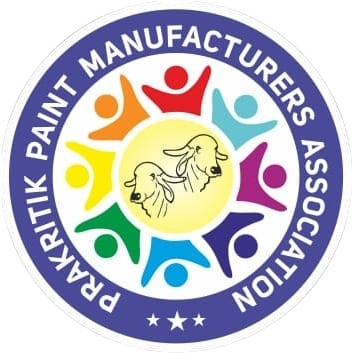Cow dung paint, also known as “Prakritik Paint” or “Gobar Paint,” is an innovative and eco-friendly alternative to conventional paints. It utilizes cow dung as its primary ingredient, offering a sustainable and environmentally conscious choice for coating walls and surfaces.
Benefits of Cow Dung Paint:
- Eco-Friendly: Cow dung paint is made from natural and biodegradable materials, primarily cow dung, a readily available agricultural byproduct. This reduces waste and reliance on petroleum-based chemicals found in traditional paints, minimizing environmental impact.
- Non-Toxic: Unlike many conventional paints that contain harmful volatile organic compounds (VOCs), heavy metals, and other toxins, cow dung paint is generally free from these substances.This makes it a healthier option for indoor environments, reducing the risk of allergies, respiratory issues, and other health concerns.
- Antimicrobial and Antifungal: Cow dung possesses natural antimicrobial and antifungal properties. Paint made from it can inhibit the growth of bacteria, fungi, and mold on painted surfaces, contributing to a cleaner and healthier indoor environment.
- Thermal Insulation: Some studies and traditional knowledge suggest that cow dung has thermal insulation properties. Applying cow dung paint may help regulate indoor temperatures, keeping interiors cooler in summer and warmer in winter, potentially reducing energy consumption for heating and cooling.
- Odorless: The manufacturing process of cow dung paint typically eliminates any unpleasant odor associated with raw cow dung, resulting in a paint that is generally odorless during and after application.
- Cost-Effective: Cow dung is an inexpensive and locally available resource in many agricultural regions, making cow dung paint a potentially cost-effective alternative to synthetic paints.
- Supports Rural Economy: The production of cow dung paint can create employment opportunities in rural areas and provide an additional income source for farmers and cow shelters (Gaushalas).
- Traditional Aesthetic Appeal: Cow dung paint can offer a unique, natural, and earthy aesthetic to interiors and exteriors, appealing to those who appreciate traditional and sustainable design.
- Breathable: It allows walls to breathe, preventing moisture buildup and contributing to a healthier indoor environment.

Manufacturing Process of Cow Dung Paint:
The manufacturing process of cow dung paint typically involves several steps:
- Raw Material Collection and Preparation: Fresh cow dung is collected from reliable sources. It is then cleaned to remove any impurities like stones or straw.
- Refining: The cow dung is typically refined using double- or triple-disc refiner machinery. This process involves mixing the cow dung with water to create a slurry and then processing it to obtain a fine, lump-free consistency.
- Bleaching (Optional): To achieve a white base for the paint, the cow dung slurry may bleach using agents like sodium hydroxide and hydrogen peroxide. This step converts the cow dung into Carboxymethylcellulose (CMC), a crucial component in paint manufacturing.
- Mixing with Additives: The refined or bleached cow dung mixture is then combined with other natural ingredients to impart desired properties to the paint. These additives can include:
- Binders: Natural binders like lime (calcium carbonate or slaked lime), natural gums (e.g., gum arabic), or plant-based polymers are added to bind the components together and ensure adhesion to the surface.
- Thickeners: Natural thickeners like xanthan gum or cellulose derivatives are used to achieve the desired viscosity and consistency of the paint.
- Pigments: Natural pigments derived from plants, minerals, or other natural sources are added to create a range of colors.
- Fillers: Substances like calcium carbonate may be added as fillers to improve opacity and coverage.
- Preservatives: Natural preservatives like sodium benzoate or neem extracts may be added to prevent microbial growth and extend shelf life.
- Other Additives: Depending on the desired properties, other natural additives like linseed oil or turmeric may be incorporated.
- Grinding and Dispersion: The mixture is thoroughly ground and dispersed using machinery like bead mills or pug mills to ensure uniform distribution of all components and a smooth consistency.
- Quality Control: The paint undergoes quality checks to ensure it meets the required standards for viscosity, color consistency, drying time, and other performance parameters.
- Packaging: Finally, the cow dung paint is packaged in suitable containers for distribution and sale.
It’s important to note that the exact manufacturing process and the specific ingredients used may vary depending on the manufacturer and the desired properties of the final product. Some formulations may focus on creating distemper-type paints, while others aim for emulsion-type finishes by incorporating different binders and additives.
Cow dung paint represents a significant step towards sustainable and eco-conscious building materials, offering a blend of traditional wisdom and modern innovation. As awareness about environmental issues and the importance of healthy living spaces grows, cow dung paint is gaining recognition as a viable and beneficial alternative to conventional paints.
